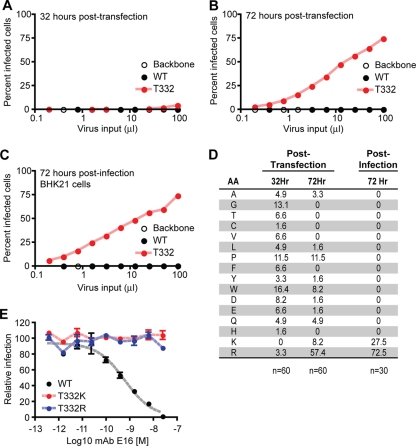Fig 5.
Directed evolution of WNV: rapid escape from a neutralizing antibody. A PCR fragment containing random nucleotides at all three positions of codon 332 of the E protein was generated by overlap-extension PCR using degenerate primers and ligated into pWNV-GFP-backbone. Ligation reaction mixtures were transfected into HEK-293T cells in the presence of a high concentration of E16 (5 μg/ml). PCR amplicons encoding the WT sequence were processed in parallel. Transfections of ligation reaction mixtures lacking the structural gene fragment (Backbone) were included as a negative control. (A and B) Virus-containing supernatants were harvested from transfected HEK-293T cells at 32 h (A) and 72 h (B) posttransfection, and titers were determined in the presence of 5 μg/ml of E16 using Raji-DC-SIGNR cells as described above. (C) A single passage of virus harvested from transfected cells at 72 h posttransfection on BHK-21 cells was performed in the presence of E16 (5 μg/ml). The titer of virus released from BHK-21 cells at 72 h postinfection was determined, and the virus was sequenced as described above. (D) The proportion of T332 codons encoding a particular amino acid (AA) was monitored by sequence analysis of viral RNA. RNA was isolated from culture supernatants and used to amplify the structural gene segment. PCR products were cloned into the pDonr221 entry vector by using Gateway cloning (Invitrogen). The percentages of clones that encoded a particular amino acid are presented for viruses harvested from transfected cells (n = 60 for viruses in panels A and B) and infected cells (n = 30 for viruses in panel C). (E) Sensitivity of the T332K and T332R variants to neutralization by MAb E16. The prME fragments encoding the T332K or T332R variant were cut from the constructed clones in panel C and ligated into plasmid pWNV-GFP-backbone to generate viruses. Titers of virus-containing supernatants were then determined on Raji-DC-SIGNR cells, and the virus was tested for sensitivity to neutralization by E16 as described previously (57).

